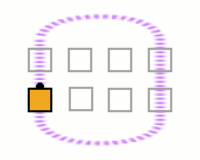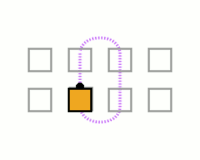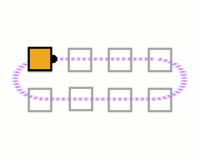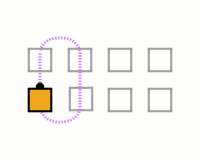
The first step in being prepared to do this is of course to be sure you know how to do a whole circulate, for each of the basic circulates. If you have any doubts at all, review them. You should already feel entirely comfortable doing both All 8 Circulate and Split Circulate from all of the common positions.
The key to dealing with both of these aspects of Challenge dancing is to understand that, for these kinds of calls, what the other dancers are doing mostly doesn't matter. Where you should be trying to go and which wall you face on a Circulate or a Split Circulate has nothing to do with what anybody else is doing. Except in cases where you are going to "crash" with another dancer (which is not usually the case for a full circulate), your ending position and facing direction are entirely determined by your own starting position and facing direction -- nobody else matters.
To be successful dancing these calls in phantom and t-bone formations, you must concentrate on your own path -- and only your own path. Take, for example, All 8 Circulate from any kind of parallel lines. If you are an end dancer, your path consists of the outside four spots. Each circulate takes you to the next one of those spots. It doesn't matter if the centers are also oriented as if in some kind of lines, oriented as if in some kind of columns, or whether you can see them at all. You just go to your next spot, among the four in your own path.

How do you know that you are "in some kind of parallel lines", if some of the dancers are facing a different wall, or if you can't see them at all? In any 2x4, if you are facing along the short axis of the formation, then you circulate as if you were in lines. What the other dancers think they are doing doesn't matter.
If you are in the center and facing along the short axis, then you circulate as if you were in the center of some kind of lines.

On the other hand, if you are facing along the long axis, then you circulate as if you are in columns. Note that in this case the path consists of eight spots.

Notice something very important about all of these paths. For every segment of the path, the dancer is either going straight forward, without turning, or the dancer is "flipping over" to face the opposite direction (turning 180 degrees). There are no other possibilities. So in a t-boned situation some dancers might start facing a head wall, and others start facing a side wall, but the dancers who start facing a head wall will always end facing a head wall, and the dancers who start facing a side wall will always end facing a side wall.
For a Split Circulate, the path always consists of four spots, the four spots in your half of the entire formation. Again, if you start facing a head wall you will always end facing a head wall, and if you start facing a side wall you will always end facing a side wall.

Then run the animation to see if the dancers move as you expect -- and if they pass each other do they pass by the shoulder you expect. If not, go back and try to figure out why. (Note: Don't use these particular animations as a guide to the actual spacing of the dancers after 1/2 of a circulate -- they were not designed for that. But they will show which dancers are on which side of each other as they pass.)
Then do the same with the Split Circulate examples.
In all of these paths, for some segments the dancer goes straight ahead, without turning. In a 1/2 circulate along that segment, the dancer still does not turn.
In all of these paths, for some segments the dancer turns around 180 degrees. In a 1/2 circulate along that segment, the dancer turns just 90 degrees.
So for a 1/2 All 8 Circulate or a 1/2 Split Circulate, every dancer either does not turn at all, or turns exactly 90 degrees.
If the two dancers are following different paths, one inside the other, they maintain that relationship throughout the whole action, and that will determine their relative position if they stop halfway. The one who was following the outer path will be on the outside, and the one who was following the inner path will be on the inside. Depending on which direction they were going, they might end up holding right hands, or they might end up holding left hands. This is not a "crash".
A "crash" happens when two dancers are circulating in opposite directions along the same path. If they were going to continue onward then they would pass right shoulders. But if they stop halfway, they can't stop in the same place, so they take right hands. (Notice that this isn't some weird extra rule - this is just where they would have been if they had originally planned to pass right shoulders but then suddenly for some reason stopped.)
So for a 1/2 Circulate, you often do need to take what somebody else is doing into account. The situation that is most likely to be confusing is when you are the end of a line facing outward, because you need to be aware of the way that the person at the other end of the same line is facing, and you may have relatively little awareness of that person. If that person is also facing outward as the end of a line, you will be trying to follow the same path, so you will "crash", and have right hands.

If not, then you won't be crashing, and anyone that you stop next to will actually have been travelling along a different path. The dancer who was on the inside path will simply end up inward of the dancer who was on the outside path.

For other cases, it is still important to understand the general principles involved, but you are less likely to make a mistake because the other person will be starting closer to you, in many cases immediately adjacent to you.
Here are some specific cases that you should be sure to understand:
First, if two end dancers crash, they will become ends of the resulting formation, and if two center dancers crash they will become centers of the resulting formation. This will be true regardless of whether the centers were originally "facing out", which may cause them to expect to become ends. Because the ends are also meeting, "further out", the centers remain centers.

Second, if two dancers who were originally t-boned to each other meet, they cannot "crash". This is because they cannot have been circulating on the "same path". One of them will have been on a curved path, and the other on a straight path. The straight path is considered to be "inside" the curved path, and that is what will determine their relative position at the end of the 1/2 circulate.
